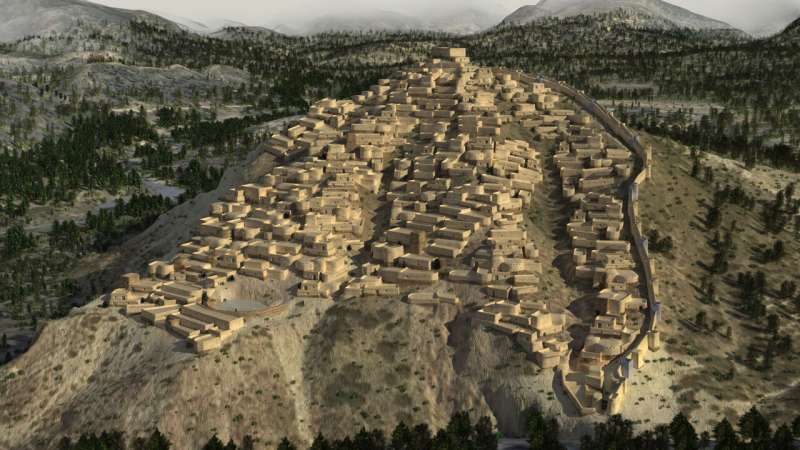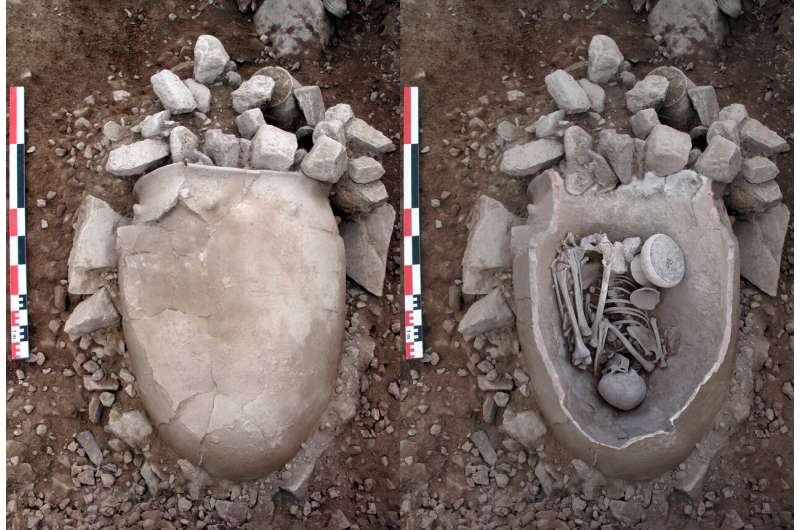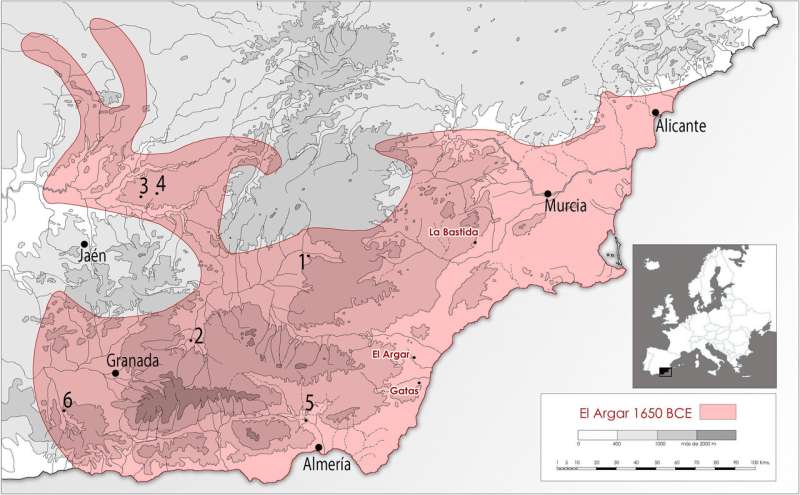Intensive management of crops and livestock spurred La Bastida's economic development

A team from the Research Group in Mediterranean Social Archaeology (ASOME) at the Universitat Autònoma de Barcelona (UAB) has led an international study to reconstruct the diet of the El Argar society of the southeast of the Iberian Peninsula (2220-1550 BCE) and distinguish the subsistence strategies of the populations of this archaeological complex. Published in PLOS ONE, the study was conducted with biological material extracted from the excavation site of La Bastida in Totana, Murcia, one of the oldest cities in Europe, and from another smaller site known as Gatas, located in Turre, Almeria.
This is the first project that analyzes all levels of the food chain of a prehistoric society in the Western Mediterranean—plants, herbivores, carnivores and omnivores. The combined analysis of stable nitrogen and carbon isotopes, found among the different types of plants and both terrestrial and marine animals, has allowed scientists to reconstruct the whole food chain and interpret results based on a highly reliable set of comparative data.
In addition to the members of the ASOME group at the UAB Department of Prehistory, participating in this study were researchers from the Curt-Engelhorn-Centre of Archaeometry gGmbH in Mannheim (Deutschland), the Danube Private University-Centre of Natural and Cultural Human History, Krems (Austria), as well as the CTFC—AGROTECNIO Mixed Unit and the University of Lleida (Spain).
Similar Diets, Different Management of Livestock
To conduct the study, researchers analyzed the human remains of 75 individuals (52 from La Bastida and 23 from Gatas), the bone collagen of 29 animals and 105 charred cereal grains (76 barley grains and 29 wheat grains). The study indicates that both settlements had a similar diet, mainly based on the consumption of barley and to a lesser extent wheat, with some meat and dairy products. However, they applied different subsistence strategies.
The inhabitants of La Bastida worked the fertile Guadalentín valley, far from the mountain slopes and non-arable lands surrounding the city. Their animals grazed on these lands and fed on stubbles, possibly in enclosures built after harvesting the fields. This complementary management of livestock made animal dung a valuable manure for these lands, increasing its fertility and crop productivity. At Gatas, in contrast, the population took on a more extensive management strategy, with a large amount of forage originating from the natural resources found near the settlement.

"La Bastida practiced more intensive land management, combining agriculture and animal husbandry, and this allowed them to increase their farming economy and feed a considerably high population—1000 people at that time," explains Cristina Rihuete, researcher at the UAB Department of Prehistory. "Although they grew crops in fields that were more degraded due to intensive usage, this system meant that they had a better productive economy when compared to other smaller populations in their vicinity. Here lies one of the previously unsuspected differential economic successes of La Bastida's land management, which undoubtedly worked in favor of their political and regional dominance."
The data points to the decline of La Bastida beginning around the year 1750 BCE. "Diets poorer in protein and more intensive farming are evidence of a subsistence crisis that, according to our hypothesis, brought the El Argar society to an abrupt end. However, we must continue our research to confirm this," says Roberto Risch, also researcher at the UAB Department of Prehistory.
Weaning Before the Age of Two
The study established, for the first time, the age of infant weaning during the Bronze Age in the Iberian Peninsula. Analysis of infant remains indicates that between 18 and 24 months, all infants had culminated the process of substituting breastfeeding with a diet mainly based on cereal pap.
Males and females ate the same things at La Bastida, but the fact that the three individuals found in the two wealthiest tombs (two women and one man) yielded a larger proportion of meat and dairy products in the analyses points to a differentiation in social classes.

Call to Review Prehistoric Diet Studies
These results and the comparison with isotopic studies of other settlements in which only human remains had been studied sheds doubt on the reconstructions previously made of a prehistoric diet. According to the researchers, it is advisable to review this information.
"If we had analyzed only human bones, we would have come to the conclusion that the inhabitants of La Bastida and Gatas had different diets," says Corina Knipper, researcher at the Curt-Engelhorn-Centre of Archaeometry in Mannheim and lead author of the paper.
The study points out that the variation in nitrogen led to deduce that the former had a diet based mainly on meat and dairy products. However, that was not so due to the amount of milling equipment and grain storage facilities found at La Bastida.
"The analysis of the isotope composition of the grain has allowed us to pinpoint the reason for this difference. The high values of nitrogen-15 in individuals from La Bastida are the result of a greater presence of this natural isotope in livestock manure and its transfer to the cereal grains which were their staple food," says Jordi Voltas, researcher at the CTFC—AGROTECNIO Mixed Unit and the University of Lleida.
More information: Knipper C, Rihuete-Herrada C, Voltas J, Held P, Lull V, Micó R, et al. (2020) Reconstructing Bronze Age diets and farming strategies at the early Bronze Age sites of La Bastida and Gatas (southeast Iberia) using stable isotope analysis. PLoS ONE 15(3): e0229398. doi.org/10.1371/journal.pone.0229398
Journal information: PLoS ONE
Provided by Autonomous University of Barcelona





















